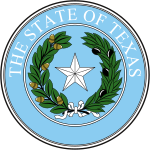| ||||||||||||||||||||||||||||
All 30 Texas seats to the United States House of Representatives | ||||||||||||||||||||||||||||
|---|---|---|---|---|---|---|---|---|---|---|---|---|---|---|---|---|---|---|---|---|---|---|---|---|---|---|---|---|
| ||||||||||||||||||||||||||||
| ||||||||||||||||||||||||||||
| Elections in Texas |
|---|
 |
|
|
The 1992 United States House of Representatives elections in Texas occurred on November 3, 1992, to elect the members of the state of Texas's delegation to the United States House of Representatives. Texas had thirty seats in the House, apportioned according to the 1990 United States census.[1]
Intraparty conflict embroiled the Texas Democratic Party, who had gained complete control of Texas' government following Ann Richards' victory in the 1990 gubernatorial election.[2] State Senator Eddie Bernice Johnson chaired the redistricting subcommittee and drew maps with the intention of creating minority-majority districts in Dallas for herself to run in.[3][4] This drew the ire of representatives Martin Frost and John Wiley Bryant, whose districts would become considerably more White and Republican-leaning as a result. A majority-Hispanic district was also created in Houston alongside District 18, a plurality-Black district. The Texas Legislature sided with Johnson's plan and adopted new congressional districts during a special session in 1991.[5][6]
These elections occurred simultaneously with the United States Senate elections of 1992, the United States House elections in other states, the presidential election, and various state and local elections. As of 2020, this is the last time the Democratic Party won the popular vote in Texas's U.S. House races,[7] though Democrats would continue to hold a majority of House seats until 2004.
- ^ "1990 Census Apportionment Results". Census.gov. Retrieved June 14, 2022.
- ^ Kennedy, J. Michael (November 7, 1990). "Democrat Richards Wins Bitter Contest With Williams : Texas: The governor's race was the state's longest, most expensive and perhaps most rancorous. GOP oilman's verbal gaffes damaged his chances". Los Angeles Times. Retrieved August 2, 2022.
- ^ Burka, Paul; Hart, Patricia; October 1991 0, Ellen Williams (October 1, 1991). "1991: The Best and the Worst Legislators". Texas Monthly. Retrieved August 2, 2022.
{{cite web}}: CS1 maint: numeric names: authors list (link) - ^ Burke, Anabel. "Eddie Bernice Johnson". Waco History. Retrieved August 2, 2022.
- ^ Edsall, Thomas (May 21, 1991). "TEXAS REDISTRICTING A CASE STUDY OF DEMOCRATS' STRUGGLE". The Washington Post. Retrieved August 2, 2022.
- ^ "History". redistricting.capitol.texas.gov. Retrieved June 17, 2022.
- ^ Bickerstaff, Steve (2007). Lines in the Sand: Congressional Redistricting in Texas and the Downfall of Tom Delay. Austin, Texas: University of Texas Press. p. 29. ISBN 978-0-292-71474-8.

